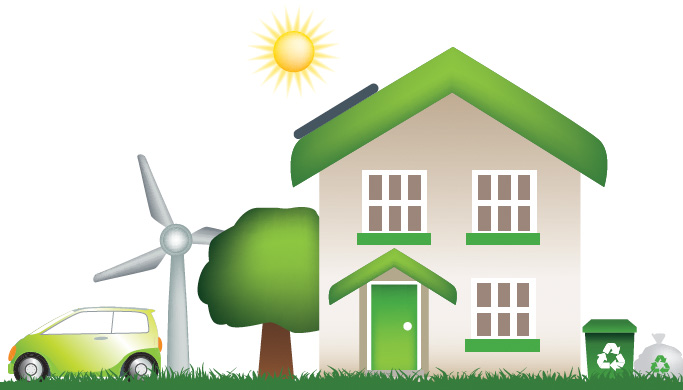Home Improvement
6 Eco-Friendly Home Improvements That Will Also Save You Money

In this era of rapidly advancing technology and growing awareness about environmental conservation, many homeowners are seeking eco-friendly solutions. Whether you are concerned about your carbon footprint or aiming to lower your energy bills, this article will guide you through six practical and eco-friendly home improvements. Not only will these tips help you make a positive impact on the environment, but they’ll also allow you to save money in the long run.
- Invest in Solar Panels
First on the list is a popular and effective eco-friendly solution: solar panels. These devices can drastically reduce your reliance on grid electricity, thereby reducing carbon emissions and saving money. As reported by Supanet, the future of home improvement lies in renewable energy resources, and solar panels are leading the charge.
- Install Energy-Efficient Appliances
Next up is swapping out old, energy-consuming appliances for new, energy-efficient models. Modern appliances come with energy ratings that help you understand their energy consumption level, which in turn helps in choosing devices that have minimal environmental impact and can save you money on electricity bills.
- Smart Home Devices
Smart home devices not only offer comfort and convenience but can also contribute to energy savings. For instance, a smart thermostat can adapt to your routines, adjusting the temperature when you’re out, and ensuring optimal comfort when you’re home. But be aware, as with any technology, there might be hidden dangers to consider, so always do your due diligence.
- Water Conservation
Consider installing low-flow faucets and showerheads, along with dual-flush toilets, which can significantly reduce your water consumption. Additionally, you could collect rainwater for watering your plants or cleaning your car, which is an effective way to conserve water.
- Improve Insulation
Proper insulation is crucial for maintaining a comfortable indoor temperature, regardless of the weather outside. Insulating your walls, ceilings, and floors will keep your home warm during the winters and cool during the summers, reducing the need for heating and cooling systems.
- Emergency Preparedness
Lastly, as climate change continues to wreak havoc and cause unforeseen natural disasters, it’s essential to be prepared for emergencies, such as power outages. For example, in the event of a prolonged power outage, do you know how to keep your food edible without refrigeration, or how to cook without electricity? Being prepared can make such situations less stressful and more manageable.
To this end, it’s worth noting a comprehensive guide I recently came across titled Blackout USA. This guide details effective strategies for surviving massive, nationwide blackouts, covering topics like preserving food without refrigeration and managing communication in the absence of electronic devices.
In conclusion, home improvements are not just about aesthetic upgrades. They can also contribute to an eco-friendly lifestyle and significant savings on energy bills. With these six tips, you can take steps towards creating a home that’s not only comfortable and beautiful but also kinder to the environment and your wallet.
Building Materials Matter
Beyond what’s inside your home, the materials used to construct it also play a significant role in its eco-friendliness. Opting for sustainable building materials such as bamboo, reclaimed wood, or recycled steel is a great way to reduce the environmental impact of your home. These materials are not only durable and cost-effective but also require less energy to manufacture compared to traditional construction materials. Moreover, sustainable materials often have unique aesthetics, adding an additional layer of appeal to your eco-friendly home.
Landscaping for Sustainability
Landscaping is another area where you can make eco-friendly changes. Start by choosing local plants that are accustomed to your region’s climate, which will require less water and care to thrive. You could also create a rain garden, which is a sunken area in your lawn that collects rainwater and allows it to seep into the ground. Rain gardens not only help conserve water but also add a unique aesthetic touch to your outdoor space.
The Power of Natural Light
Leveraging natural light can make a significant difference in both your energy consumption and the ambiance of your home. Installing skylights, larger windows, or simply rearranging your furniture to allow more sunlight can reduce your dependence on artificial lighting during the day. Besides, natural light is known to have various health benefits, including boosting mood and enhancing productivity.
-
Blog1 year ago
MyCSULB: Login to CSULB Student and Employee Portal – MyCSULB 2023
-
Android App3 years ago
Cqatest App What is It
-
Android1 year ago
What Is content://com.android.browser.home/ All About in 2023? Set Up content com android browser home
-
Software2 years ago
A Guide For Better Cybersecurity & Data Protection For Your Devices
-
Latest News2 years ago
Soap2day Similar Sites And Alternatives To Watch Free Movies
-
Android2 years ago
What is OMACP And How To Remove It? Easy Guide OMACP 2022
-
Android3 years ago
What is org.codeaurora.snapcam?
-
Business2 years ago
Know Your Business (KYB) Process – Critical Component For Partnerships





















